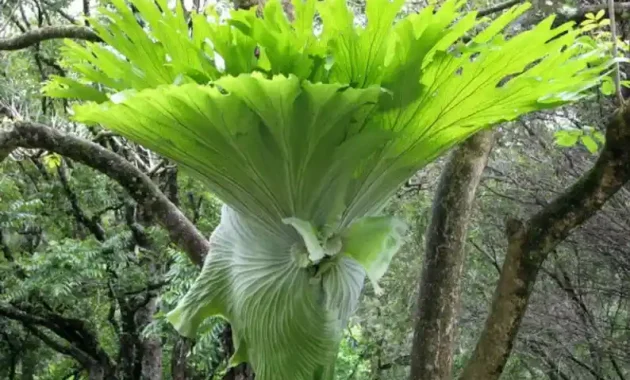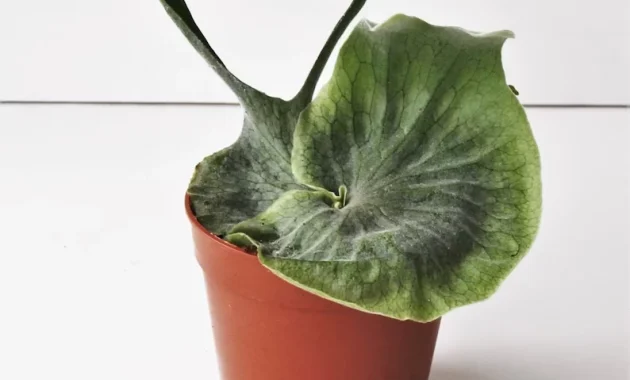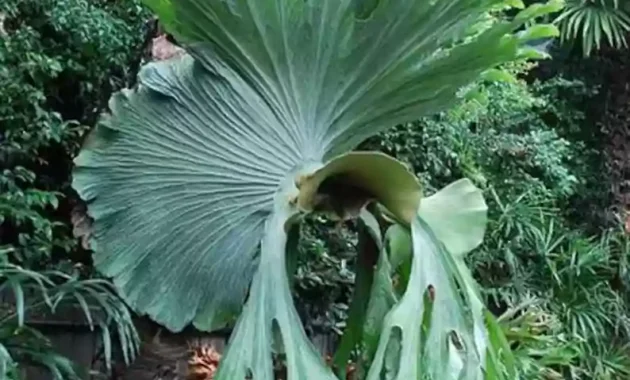Platycerium Superbum, commonly referred to as the Queen of Ferns, is a distinct variety of the Platycerium genus, distinguished by its unique, ornate fronds that resemble a royal crown. This description is not only a testament to the fern’s aesthetic allure but also to its robust adaptability.
Native to the subtropical rainforests of eastern Australia, it can also be found in parts of Indonesia, Malaysia and New Guinea, this epiphytic fern thrives in humid, shaded environments. However, its survival is not limited to these conditions, exhibiting remarkable resilience when nurtured in diverse climates.
The subsequent sections delve into the natural habitat, care and maintenance requirements, propagation techniques, and common issues faced by this fern. The intent is to provide a comprehensive understanding of the requirements for the successful cultivation of Platycerium Superbum, thereby enabling enthusiasts and researchers to appreciate and enhance the growth of this majestic plant.
This treatise aims to shed light on its botanic intricacies, emphasizing its scientific attributes and care necessities.
Key Takeaways
- Platycerium Superbum is a distinct variety of the Platycerium genus, known as the Queen of Ferns.
- It is native to subtropical rainforests of eastern Australia and thrives in humid, shaded environments.
- The fern grows as an epiphyte, with fronds growing directly from the trunk of a host tree.
- Proper prevention and treatment measures are important for maintaining the health of Platycerium Superbum, including water management, balanced fertilization, and treatment for issues like overwatering and root rot.

Overview of the Queen of Ferns
Renowned as the ‘Queen of Ferns,’ Platycerium superbum is a majestic species that effortlessly commands admiration with its unique, broad fronds, and a regal appearance that lends itself to the lush tapestry of the world’s rainforests.
This species, a part of the Polypodiaceae family, has its roots deeply interwoven with fern symbolism and cultural significance, with its intricate patterns inspiring various forms of artwork and folklore.
The plant thrives under special conditions, requiring high humidity and well-draining soil, with a preference for indirect bright light. Its epiphytic nature, with fronds growing directly from the trunk of the host tree, offers a captivating spectacle.
Delving deeper into the life of this illustrious fern reveals a compelling intertwining of nature’s grandeur and resilience, leading us into a discussion on its natural habitat.
Natural Habitat
In the humid, subtropical rainforests of eastern Australia, this majestic epiphytic fern can be found thriving, often clinging to the trunks and branches of towering trees.
The geographic distribution of Platycerium superbum is primarily located in Queensland and New South Wales, where the climate influence is significant. It thrives in areas with high humidity, consistent rainfall, and indirect sunlight.
The fern’s unique morphology, characterized by its large, bifurcated fronds, is well-adapted to collect falling plant debris and rainwater, ensuring its survival in this ecosystem. The species is also capable of enduring minor temperature fluctuations, although it is not frost-tolerant.
Understanding these factors provides insight into the plant’s ideal growing conditions, paving the way for a detailed discussion on effective care and maintenance.
Care and Maintenance
An in-depth exploration into the care and maintenance of Platycerium superbum, colloquially known as the queen of ferns, uncovers vital aspects such as watering requirements, ideal soil composition, and light requirements.
These factors play a significant role in the overall health and growth of this species.
The watering regime must be meticulously managed, the soil composition should be nutrient-rich and well-draining, and the light conditions should strike a balance between promoting photosynthesis and preventing damaging exposure.
Watering Requirements
Optimal hydration for the Platycerium superbum necessitates a careful balance, as this fern species thrives in well-drained soil that is consistently moist, but not saturated. The fern’s hydration needs are influenced by several factors:
- Humidity Levels: This fern flourishes in high humidity conditions, necessitating regular misting to maintain adequate moisture.
- Drought Tolerance: Despite its preference for constant moisture, Platycerium superbum shows a surprising degree of drought tolerance, being able to withstand brief periods of dryness.
- Seasonal Changes: The watering frequency should be adjusted according to the seasons, with less water needed during the cooler, dormant months.
An understanding of these elements will aid in achieving the optimal watering balance for this queen of ferns. This knowledge seamlessly leads into the exploration of the ideal soil composition for Platycerium superbum.
Ideal Soil Composition
Understanding the perfect soil composition for this majestic epiphytic plant requires a keen comprehension of its natural habitat and growth requirements. The Platycerium superbum thrives best in a well-draining substrate rich in organic matter with a slightly acidic to neutral soil pH level.
| Soil Type | Soil pH levels | Nutrient availability |
|---|---|---|
| Composted bark | 5.5 – 6.5 | High |
| Coir fiber | 6.0 – 6.7 | Moderate |
| Peat moss | 4.0 – 4.5 | Low |
The soil pH levels directly affect nutrient availability, determining how well the plant can absorb essential nutrients. Adjusting the pH levels and incorporating organic matter such as composted bark or coir fiber can greatly enhance the plant’s growth. The next section delves into the light requirements of Platycerium superbum, a crucial aspect of its care.
Light Requirements
In the realm of horticulture, comprehending the light requirements of this regal epiphyte is fundamental to fostering its thriving growth and radiant foliage. The Platycerium superbum, or Staghorn fern, requires a delicate balance of light for optimal growth. High light intensity can cause leaf burn, while inadequate light can result in reduced photosynthesis and growth.
- Light Requirements:
- Bright, but indirect sunlight: Too direct or harsh sunlight can damage the delicate fronds.
- Partial shade: A location with dappled shade, like under a tree canopy, is ideal.
- Indoor positioning: If grown indoors, a north or east-facing window is best to avoid intense afternoon sun.
Fern fertilization can be influenced by light conditions, with better light exposure increasing nutrient uptake. As the discussion transitions to propagation techniques, understanding these elements of care is crucial.

Propagation Techniques
Successful propagation of Platycerium superbum requires a combination of several techniques, including spore collection, sowing, and transplanting.
The process commences with fern hybridization, a method that combines different fern species to produce a new variation. This particular fern produces spores beneath its fronds that can be collected and sown into a suitable growing medium.
Spore collection is done when the spores mature and turn brownish. The subsequent sowing of the spores in a moist, well-drained medium under controlled environmental conditions is crucial for germination.
Transplanting, which involves moving the young fern to its final growing location, is done once the fern has developed sufficient root structure.
Understanding these propagation techniques is essential before delving into the common issues and resolutions associated with cultivating Platycerium superbum.
Common Issues and Solutions
Delving into the realm of common issues and solutions related to Platycerium superbum, it becomes evident that pests and diseases, along with overwatering leading to root rot, are principal concerns.
These challenges can significantly affect the plant’s health, leading to stunted growth, discoloration, and even plant death.
Thus, it is imperative to elucidate the appropriate prevention and treatment measures to curb these problems and ensure the optimal growth and development of this majestic plant species.
Pests and Diseases
Platycerium superbum, often referred to as the queen of ferns, can become susceptible to a variety of pests and diseases, including scale insects, mealybugs, and fungal infections, which can compromise the plant’s health and vibrancy.
- Scale insects are small pests that attach themselves to the leaves and stems, feeding on the plant’s sap and causing discoloration and wilting.
- Mealybugs present as fuzzy white spots on the plant, damaging the fern by sucking its sap, leading to stunted growth and leaf drop.
- Fungal infections, visible as black spots or a powdery white coating, can lead to leaf loss and ultimately, plant death.
Application of Fern Fungicides and Pest Repellants can mitigate these threats, preserving the plant’s health.
The importance of watering practices cannot be overstated, as it directly influences the potential for root rot afflictions, the focus of the next discussion.
Overwatering and Root Rot
Transitioning from the discussion of pests and diseases, a particular issue that deserves attention pertains to the challenges posed by overwatering and root rot in platycerium superbum, the queen of ferns. Just like other plants, this fern requires a delicate balance in hydration.
Overwatering can lead to an oversaturated root system, which in turn encourages the development of root rot. This is where the efficiency of the drainage system plays a crucial role. An optimal drainage system facilitates the expulsion of excess water, consequently preventing the roots from being waterlogged.
Failure to maintain this balance can lead to the degradation of the plant’s health, ultimately causing its demise.
The next section will delve into the prevention and treatment measures for these issues without using the term ‘steps’.

Prevention and Treatment Measures
Understanding the intricacies of prevention and treatment measures for overwatering and root rot can make all the difference in maintaining the vitality and longevity of these spectacular botanical specimens.
- Fern Fertilization: Proper fern fertilization involves maintaining balanced nutrients, essential for the platycerium superbum. Over-fertilization can lead to root burn, compromising the plant’s overall health.
- Water Management: Overwatering is a common pitfall, especially during the cooler months. The fern’s water requirements significantly decrease in low temperatures, further emphasizing the importance of understanding seasonal effects on plant care.
- Treatment Measures: Incorporate fungicides to combat root rot. It’s crucial to remove diseased fronds and roots, ensuring the rot doesn’t spread further.
Through these preventive and treatment measures, platycerium superbum, the queen of ferns, can continue to thrive, boasting its majestic fronds in all their glory.
Frequently Asked Questions
What are the historical uses of the Platycerium Superbum?”
Historically, Platycerium superbum’s unique structure has informed fern propagation techniques. Care for this species involves replicating its native Australian rainforest environment, thus lending its use in educational and horticultural contexts.
Are there any medicinal properties associated with the Queen of Ferns?”
While employing Fern Propagation Techniques and Indoor Planting Tips, it is noteworthy that no documented medicinal properties are associated with the Queen of Ferns. Its value lies primarily in its ornamental characteristics.
How does this plant affect the local ecosystem and biodiversity where it naturally grows?”
Superbum’s adaptability enhances local biodiversity by providing habitat and food for various species. Its unique reproduction mechanism, involving spores instead of seeds, contributes to ecosystem dynamics by enabling colonization of new areas.
Are there any cultural or symbolic meanings associated with the Platycerium Superbum?”
Cultural relevance of Platycerium superbum, often associated with ‘Fern Aesthetics’, is less documented. However, its cultivation, known as ‘Superbum Cultivation’, signifies perseverance and adaptability in challenging growth conditions in horticultural narratives.
Can this plant be toxic or harmful to pets or other plants?”
Investigations into Platycerium superbum indicate no toxicity for pets, thus requiring minimal pet safety measures. As part of indoor planting tips, ensure it’s not ingested due to potential mild gastrointestinal upset in sensitive animals.
Where to Buy Platycerium Superbum?
Here are some places where you can buy Platycerium superbum:
- Etsy: There are various sellers on Etsy that offer Platycerium superbum for sale, including The Hanging Garden, WonkaPlants, and Brenlissa Online Nursery.
- Local nurseries and plant stores may also carry Platycerium superbum.
Keep in mind that availability may vary depending on the season and location. It’s always a good idea to check with the seller for specific details on shipping and handling.
Conclusion
In conclusion, Platycerium superbum, commonly known as the Queen of Ferns, demonstrates remarkable adaptability in various habitats.
The growth and maintenance conditions of this species require meticulous attention, particularly in relation to moisture, light and temperature.
Propagation techniques can be challenging but rewarding, especially when common issues are effectively addressed.
Through comprehensive understanding and appropriate care, the cultivation of this magnificent fern species can be highly successful.


